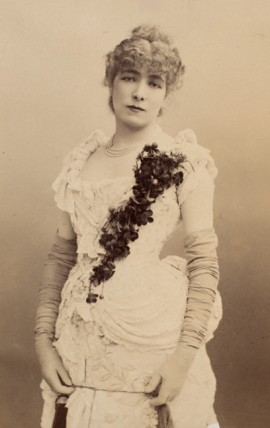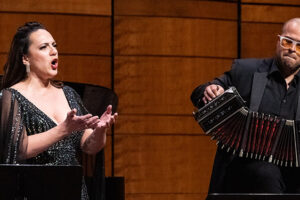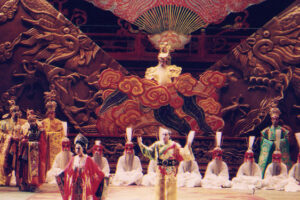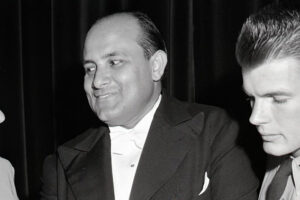
It was while attending a performance of Fédora in Naples in 1885 that eighteen year-old Umberto Giordano fell in love with Sardou’s then immensely popular play; the protagonist was none other than Sarah Bernhardt, the creator of the title role.
He immediately asked the French dramatist to sell him the rights, a request Sardou did not even take into consideration. After the composer scored modest successes with Marina, Mala vita and Regina Diaz, Sardou seemed almost persuaded to relent, although the publisher Sonzogno considered the author’s financial demands too excessive. Only after the triumph of Andrea Chénier did Sardou and Sonzogno come to an agreement, and Giordano was finally able to devote himself to his long-awaited project.
Like his later drama La Tosca, Fédora belongs to Sardou’s favorite genre, a mélange of “noir,” spy story and sex located in a definite historical moment and ideological frame, in this case the rebels (the nihilists) against the Tsarist establishment. The only difference is that whereas Cavaradossi is an active sympathizer of the revolutionaries, Loris is wrongly accused, and the character of Fédora carries in herself traces of both Tosca and Scarpia.

Sarah Bernhardt in the title role of Fédora
Giordano’s opera had its première in 1898, two years after Andrea Chénier, and was an instant hit. The title role was sung by Madame Verismo herself, Gemma Bellincioni, while Loris was a young up and coming tenor named Enrico Caruso. Fedora was wildly popular for at least forty years, relatively falling from the audience’s favor only after World War Two, together with the vast majority of Verismo operas.
In the last few decades it has been generally associated with divas no longer in their first flush of youth, so much that the simple decision by a prima donna to add this role to her repertoire is perceived by many as an implicit sign or admission of decline.
This could not be farther from the truth. Just because the part does not abound in high Cs does not make singing it a cakewalk. On the contrary, it has one of the most insidious tessituras in the entire operatic repertoire; it’s an amphibious role, straddled between the soprano and mezzo-soprano registers and hardly a good fit for either. In most of her music it’s a real puzzle for the singer to decide where to rest her vocal emission.
There is no denying that Angela Gheorghiu, the heroine of this newly released Deutsche Gramophone CD, is decidedly miscast. Her instrument, attractive but relatively fragile in the central and low register, cannot cope with much of Fedora’s tessitura. In the Andante espressivo “O grandi occhi lucenti di fede” both the G# on “ o schiette labbra” as well as the A natural of “sento che qui…” are flat. These are notes that normally do not present particular problems for her, and a possible explanation for these missteps is an effort to keep her vocal center of gravity lower than her natural one.
Her Fedora is thus mostly delicate, almost enervated. In the first act, “In questa santa croce”, which is after all the key moment where she swears vengeance, underlined by the accompanying woodwind evocative of the sound of an organ, lacks vehemence, imperiousness and solemnity.
There is scarce fervor, sense of agony in the third act desperate prayer “Dio di giustizia”, an arioso so low-lying that its climax is a low C, a note whose full importance only a true mezzo-soprano could be able to convey through a skillful use of chest voice. Gheorghiu, who normally avoids chest voice like the plague, falls flat and produces no effect whatsoever.
When she is not unduly taxed by the tessitura and can sing with her own voice, Gheorghiu proves once more that she is one of the very few sopranos with a real feeling for this type of music. In an age where singers appear to be made in same mold, with her instinctive sense of style, imaginative fraseggio, tasteful portamentos, ritardandos, and a crisp clear diction, Georghiu’s individuality is refreshing indeed. Under the right circumstances, such as her recent recording of L’amico Fritz, she sounds like a throwback to the old type of Italianate sopranos, in style more than in sound.
For example, in the first act, in the phrase “Vladimiro mio diletto”, she executes a beautiful, short, expressive “forcella” (a crescendo followed by a diminuendo) on a simple middle B natural, an embellishment that is not even written in the score. It’s just a little detail that however lends huge expressivity to the moment. The same thing happens on a lacerating “Vladimiro, son io la tua Fedora”. It is heartbreaking, just like the whole death scene, in its bare simplicity, devoid of the histrionics that this type of repertoire often invites. In a few words, we are in the presence of a sensitive singer, with an innate stylistic sense, coping for the most part with music hostile to her best attributes.
For the record, the soprano does take the high C at the end of the second act, and it’s a glorious note. It’s optional (and Giordano’s second option, you know one of those notes written in a smaller size), but the music modulation screams for it, and I always feel let down when Fedora doesn’t attempt it.
Loris Ipanoff, on the contrary, with its central tessitura, (there is only one timid B flat) and insistence on declamation, was a role that in his prime fit Placido Domingo like a glove. I seem to remember an interview where he even indicated it as his very favorite part in his entire, immense repertoire.
Frankly, I find it rather superfluous to assess Domingo’s performance in detail. He has long reached the status of an untouchable to whom everything is allowed. His participation to this project is unexplainable on pure artistic grounds. He obviously wished to add to his monumental discography a role he had never recorded before, although he appears in two commercial DVDs. In addition, recording companies obviously believe that a fatigued, struggling Domingo is still commercially more viable than almost any younger tenor.
One example will suffice: as soon a he makes his appearance in the second act, his first phrases already show a pushed, forced F natural and A natural on the words “L’amo”. “Amor ti vieta” is conspicuous for a central register with signs of oscillation and a climatic A natural so nasal and strangled that one wonders how he could have approved its release. Listing every such unpleasantness is an exercise in futility.
It is worth noting that this opera was recorded in January 2008, before his Simon Boccanegra tour and his other baritonal attempts. It is always fascinating to discover the reasons some recordings are released such a long time after their completion. If someone knows the story behind this Fedora’s delay, I would be interested indeed.
Next to a laboring old glory, we find an emerging young starlet whose fast rise to prominence is difficult to justify under a merely vocal point of view. Nino Machaidze’s soprano (Countess Olga) is metallic throughout its range and strident above the stave; as a consequence of a faulty passaggio, she flats on every single note above F.
Except for a somewhat aspirated agility in the aria “La donna russa”, Fabio Maria Capitanucci is a proficient De Siriex, expressing both the brilliant and dramatic sides of his character.
Alberto Veronesi keeps his orchestra (the excellent Orchestre symphonique de la Monnaie) as vibrant and taut as possible.
The opera is rich with dances and “stage music” performed as an insert in the action, which do not particularly benefit from Veronesi’s overwrought style. The waltz that opens the second act is not so “brillante” as indicated by Giordano. What ultimately matters is however the intense atmosphere of suspense he creates in the core of the plot, with his condensed, taut, at times violent tempos, thoroughly appropriate for such a quintessential Sardou story.

























Comments